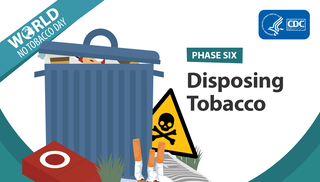Infographic

Environmental Impacts of the Tobacco Lifecycle
Phase One GROWING TOBACCO degrades soil, threatens biodiversity, and uses pesticides and fertilizers exposing farm workers to hazardous chemicals.
- 4.3 million hectares of land are used to grow tobacco (2012)
- 90% of tobacco farming is in low- to middle- income countries, with the top being China, Brazil, and India.
Phase Two TOBACCO CURING results in global deforestation for farmland and wood burning.
- By the mid-1990s, more than half of the 120 tobacco-growing low- and middle-income countries were losing a combined 211,000 hectares to deforestation annually.
- An estimated 11.4 million metric tons of wood are burned to cure tobacco every year.
Phase Three TOBACCO MANUFACTURING produces different types of environmental harm including water and energy use, hazardous waste, and greenhouse gases.
- The estimated annual emissions produced by the tobacco manufacturing process are equal to the emissions of roughly 3 million transatlantic flights.
Phase Four TRANSPORTING TOBACCO leaf and products globally yields significant air pollution.
- Exposure to air pollution can increase the risk of heart attack and stroke.
- Commercial transport contributes to air pollution.
Phase Five TOBACCO SMOKE has an impact on people who smoke, those around them, and the environment via toxic emissions and greenhouse gases.
- In a single year, cigarette smoke contributes thousands of metric tons of cancer-causing chemicals, other toxins, and greenhouse gases globally.
Phase Six DISPOSING TOBACCO and cigarette waste contribute to substantial amounts of litter and leach toxic chemicals into the environment.
- Cigarette butts are the largest single type of litter by count and their filters do not biodegrade.
- Additionally, tobacco product packaging creates 2 million tons of waste per year.
The environmental and health impacts of tobacco are vast and growing, and are particularly harmful to low- and middle-income countries.
Source:
Tobacco and its environmental impact: an overview. Geneva: World Health Organization; 2017. Retrieved from: https://apps.who.int/iris/bitstream/handle/10665/255574/9789241512497-eng.pdf
Quitting tobacco benefits your health and the environment.
Learn more: bit.ly/CDCQuitSmoking
Centers for Disease Control and Prevention
National Center for Chronic Disease Prevention and Health Promotion
Video: The Environmental Impact of the Tobacco Lifecycle
Blog: Less Paper, Healthier Planet: Tobacco Surveillance in the Field
Summary
- CDC, the government of El Salvador and international partners collaborated to conduct the first electronic Global Youth Tobacco Survey (GYTS)
- The electronic survey aligns with this year’s World No Tobacco Day theme, “Tobacco: Threat to our environment”

Teenage girl looking at a portable device
In the fall of 2021, CDC’s Global Tobacco Control Branch piloted in El Salvador the first Global Youth Tobacco Survey (GYTS) using electronic data collection (EDC) methods. CDC collaborated with Research Triangle Institute, the Pan American Health Organization, and the El Salvador Ministry of Education and Solidarity Fund for Health. Since 1999, over 180 countries worldwide have surveyed school-going youth by completing a GYTS through hardcopy answer sheets distributed to students in schools, then completed and shipped to CDC headquarters for processing. Challenges stemming from the COVID-19 pandemic, including no in-person schooling and shipping delays, severely limited the ability to conduct the GYTS. CDC worked with partners in El Salvador to pilot and subsequently developed an EDC version of the GYTS. Offering an electronic GYTS option aligns with CDC’s aim of helping countries enhance their capacity to monitor tobacco use among youth and provide information for their tobacco control programs to protect youth from harms of tobacco use.
In accord with this year’s World No Tobacco Day theme, “Tobacco: Threat to our environment,” offering an EDC process could offer significant environmental savings over time (e.g., from not involving paper, printing, shipping, travel). As Internet communication services become readily available in schools, an online GYTS survey could decrease time for fieldwork and data processing, while making data for action readily available. For example, fieldwork for the GYTS El Salvador EDC pilot was completed in approximately 2 weeks, instead of the usual 6–8-week process. CDC has already received requests from two new countries for completing an EDC version of the GYTS in 2022.
Last Reviewed: May 27, 2022
Source: Global Health














